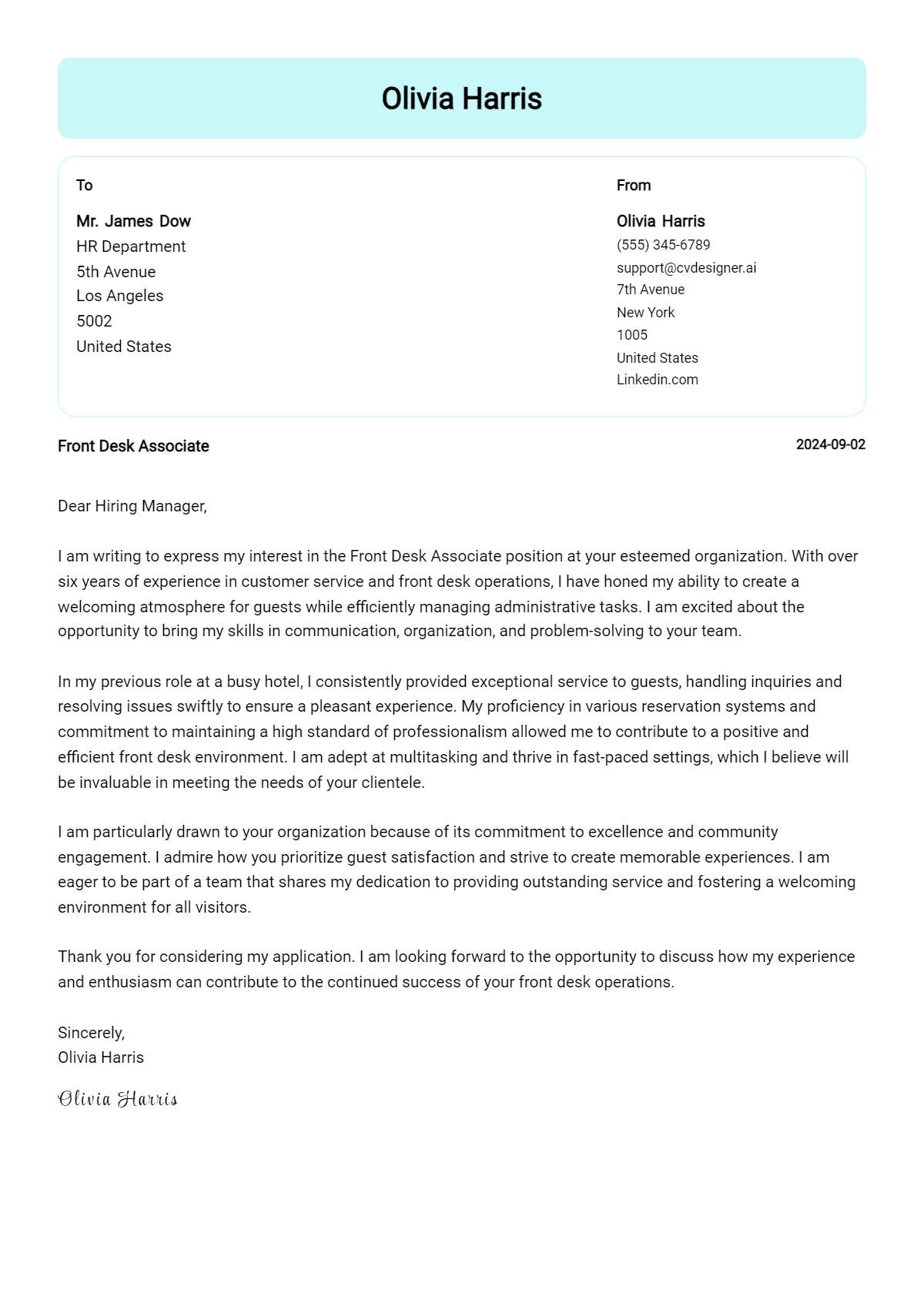Understanding the Front Desk Associate Role
A front desk associate is often the first point of contact for customers and clients, playing a crucial role in shaping their initial impression of a company. This position requires a blend of strong communication, organizational skills, and a welcoming demeanor. The front desk associate manages a variety of tasks, from answering phones and greeting visitors to handling mail and assisting with administrative duties. Their responsibilities extend beyond basic tasks, often including managing schedules, coordinating meetings, and providing information to clients or customers. A well-written cover letter must clearly demonstrate how your skills align with these multifaceted responsibilities. By showing your ability to manage these tasks effectively, you highlight your value to potential employers. Emphasizing your attention to detail and ability to multitask is crucial to proving you are a suitable candidate for the position.
Key Responsibilities of a Front Desk Associate
Front desk associates are pivotal in maintaining an organized and efficient office environment. Their daily tasks include managing phone calls, responding to emails, and directing visitors. They often handle incoming and outgoing mail, organize and maintain office supplies, and assist with various administrative duties. Furthermore, they may be responsible for scheduling appointments, coordinating meetings, and providing basic administrative support to other staff members. Efficiently managing these responsibilities is key to the smooth operation of an office. A cover letter must highlight relevant experience in these areas, demonstrating your organizational skills, time management abilities, and proficiency in communication and administrative tasks. Highlighting your capacity to handle multiple tasks simultaneously will showcase your aptitude for success in this role, underscoring your ability to contribute effectively.
Skills Employers Seek

Employers look for a range of skills in a front desk associate, including excellent communication, strong organizational skills, and proficiency in using office software. Other essential skills are time management, problem-solving abilities, and the capacity to handle multiple tasks simultaneously. A friendly and professional demeanor, along with the ability to remain calm under pressure, are also highly valued. A cover letter is your chance to showcase your possession of these skills, using specific examples to demonstrate how you have applied them in previous roles. Be sure to include keywords from the job description to demonstrate your understanding of the employer’s needs, and thus improving your chances of securing an interview. Highlighting your adaptability, reliability, and ability to work independently or as part of a team can significantly improve your application.
Crafting Your Cover Letter
Crafting a compelling cover letter is crucial to landing a front desk associate position. Your letter serves as your first impression and should effectively communicate your qualifications, experience, and enthusiasm for the role. It is not merely a summary of your resume but an opportunity to elaborate on your skills and experiences, explaining how they align with the specific requirements of the job. Tailoring your cover letter to each application is essential, demonstrating your genuine interest in the company and the position. This personalized approach showcases your attention to detail and eagerness to contribute to their team. A well-written cover letter should capture the reader’s attention and entice them to review your resume, thus increasing your chances of an interview.
Header and Contact Information
The header of your cover letter should contain your full name, contact information, and the date. Make sure your contact details, including your phone number and email address, are accurate and professional. Include the employer’s name, the hiring manager’s name (if known), and the company’s address. This information should be formatted in a clear and organized manner, allowing the reader to easily identify the essential details. Ensuring that this section is correct shows your attention to detail, a vital skill for a front desk associate. Using a professional-looking font and layout in your header adds to the overall polished presentation of your cover letter, setting a positive tone from the outset.
Personalized Greeting

Always address your cover letter to a specific person whenever possible. Research the company to identify the hiring manager or the person who will be reviewing your application. Using their name demonstrates your initiative and personalized approach, which is crucial in making a positive first impression. If you are unable to find a specific name, use a professional greeting such as ‘Dear Hiring Manager’. Avoid generic greetings like ‘To Whom It May Concern’, as they can make your letter seem impersonal and less appealing. A personalized greeting immediately captures the reader’s attention and signals that you have taken the time to research the company and the role. This demonstrates your genuine interest in the position.
Opening Paragraph Making a Strong First Impression
The opening paragraph of your cover letter should grab the reader’s attention and clearly state the position you are applying for. Briefly mention where you saw the job posting, and express your enthusiasm for the opportunity. Highlight your key qualifications and skills, focusing on how they match the requirements of the front desk associate role. Make your opening concise and compelling, providing a clear overview of your intent and qualifications. The opening paragraph sets the tone for the entire letter and will influence the reader’s decision to continue reading. Be direct and make sure to state why you are the ideal candidate, demonstrating your ability to make a strong first impression.
Highlighting Relevant Skills and Experience
In the body of your cover letter, emphasize your skills and experience that are most relevant to the front desk associate role. Provide specific examples to demonstrate your abilities, such as customer service, communication, and organizational skills. Reference your accomplishments and achievements in previous positions, highlighting how you have successfully managed similar responsibilities. Use action verbs to describe your tasks and responsibilities. Tailor this section to the specific job description, ensuring you address the key requirements outlined by the employer. Demonstrating how your past experiences align with the job’s needs increases your chances of making a favorable impression, thereby increasing the likelihood of being invited for an interview.
Showcasing Achievements with Examples
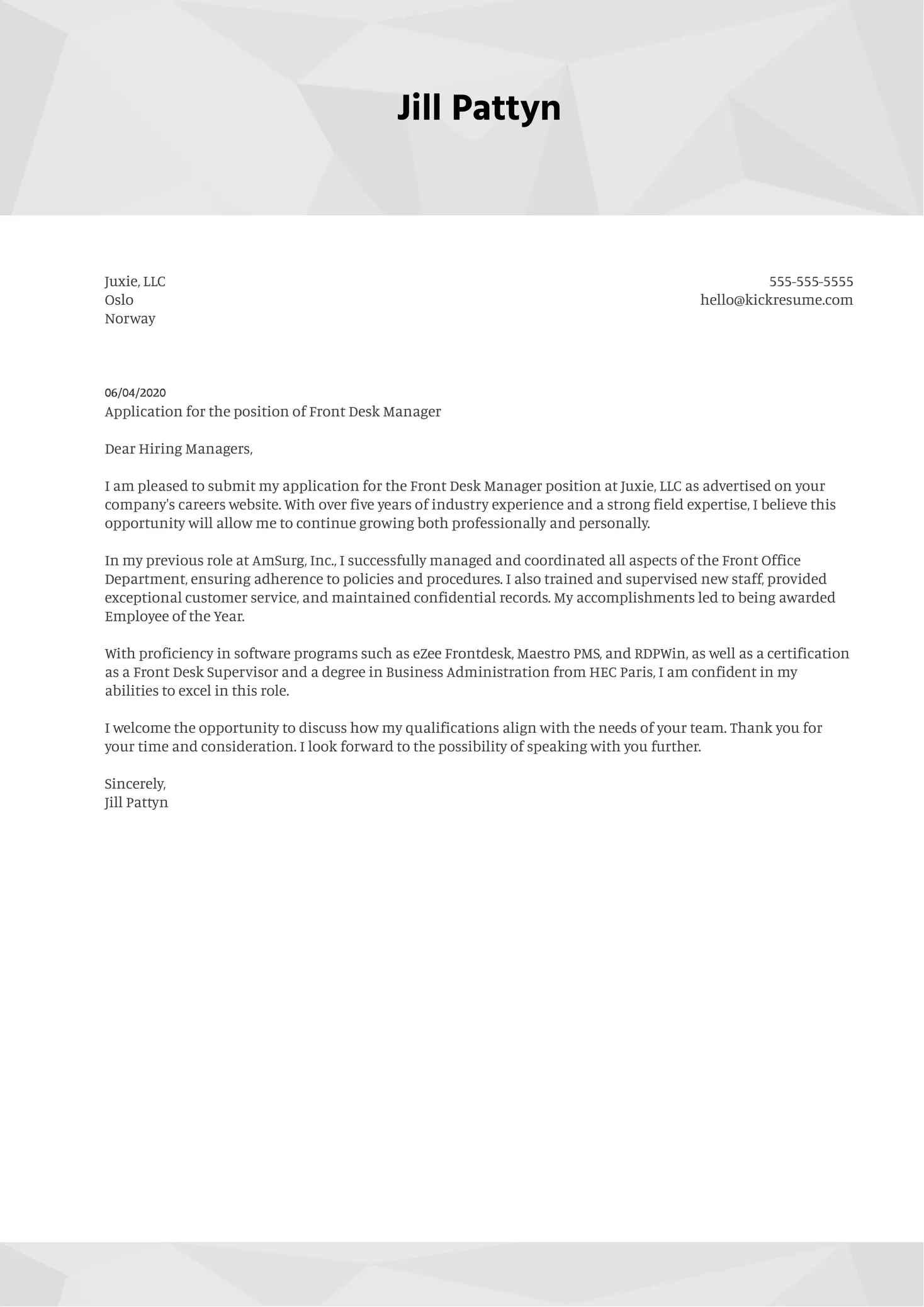
Instead of merely listing your responsibilities, showcase your achievements using specific examples. For instance, if you improved customer satisfaction in a previous role, provide the quantifiable results, such as increased positive feedback. If you implemented a new system that improved efficiency, describe the impact it had on the workplace, quantifying the time or resources saved. Use the STAR method Situation, Task, Action, Result to structure your examples. This method helps you clearly communicate your contributions and their positive impact. This approach illustrates not only your skills but also your ability to make a tangible impact in the workplace. Focusing on achievements rather than just responsibilities makes your cover letter stand out.
Quantifying Accomplishments
Whenever possible, quantify your accomplishments to provide tangible evidence of your achievements. Instead of saying ‘Improved customer service’, state ‘Increased customer satisfaction scores by 15%’. Instead of saying ‘Managed a busy reception area’, state ‘Managed a reception area with an average of 100 visitors per day’. Using numbers and data makes your claims more credible and demonstrates your ability to measure and analyze your performance. Quantifiable results instantly highlight the value you bring to the table, making it easier for employers to assess your impact. This method will set you apart from the competition and showcase your professional abilities.
Expressing Enthusiasm and Company Knowledge
Express your genuine enthusiasm for the company and the position by demonstrating your knowledge of the organization. Research the company’s mission, values, and recent achievements. Show how your skills and experience align with the company’s goals. Explain why you are interested in the specific role and what you hope to contribute. This level of engagement shows that you have taken the time to understand the company and are genuinely interested in becoming part of their team. Expressing your enthusiasm and linking your skills to the company’s objectives will make your cover letter more compelling. Highlighting what you admire about the company shows that you are proactive and dedicated.
Closing the Cover Letter
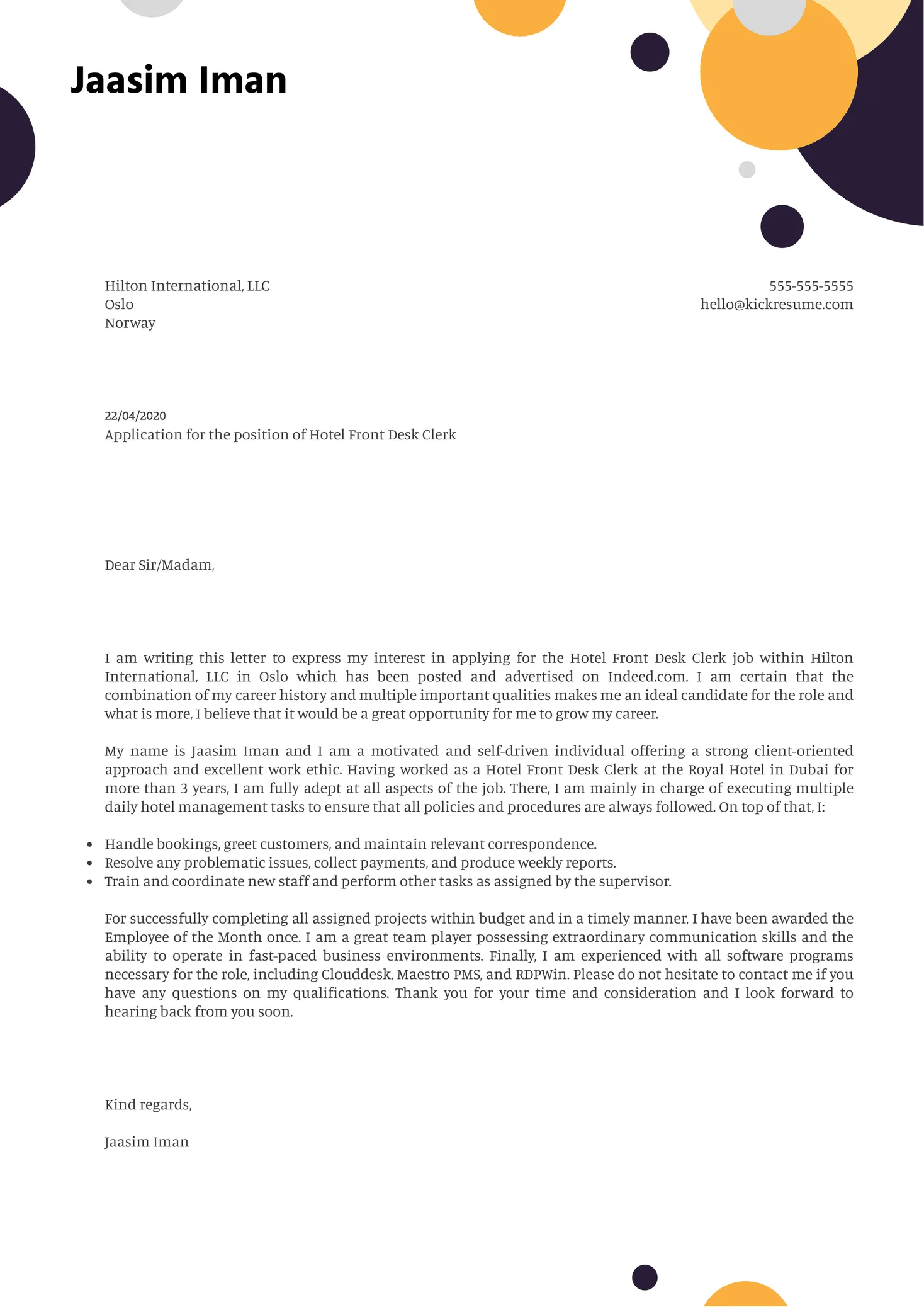
In your closing paragraph, reiterate your interest in the front desk associate position and thank the reader for their time and consideration. Reiterate your contact information and express your availability for an interview. End with a professional closing, such as ‘Sincerely’ or ‘Best regards’, followed by your typed name. Avoid sounding overly eager or presumptuous. Keeping your closing concise and professional will leave a positive lasting impression. Make sure to proofread this section to ensure there are no grammatical or spelling errors. It is the final message of your cover letter, leaving a lasting impression of professionalism and attention to detail.
Formatting and Proofreading
Your cover letter’s format and proofreading are as important as its content. Use a clear, easy-to-read font such as Arial or Times New Roman. Maintain consistent formatting throughout, including consistent spacing and margins. Ensure the letter is free of any spelling or grammatical errors. Use a professional tone and avoid slang or informal language. Before submitting your cover letter, proofread it multiple times, ideally having someone else review it as well. A well-formatted and error-free cover letter shows professionalism and attention to detail. Any mistakes or unprofessional presentation can create a negative impression, so take the time to ensure everything is perfect.
Common Mistakes to Avoid
Several common mistakes can undermine your cover letter and reduce your chances of landing a job interview. Being aware of these mistakes will help you craft a cover letter that makes a positive impression and effectively highlights your qualifications. Avoiding these errors will make sure your application shows your attention to detail and seriousness, which is crucial for any job in the front desk environment. By addressing these aspects, you create a strong, professional impression. Taking extra care to prevent these issues will result in a superior application, maximizing your chances of success.
Generic Cover Letters
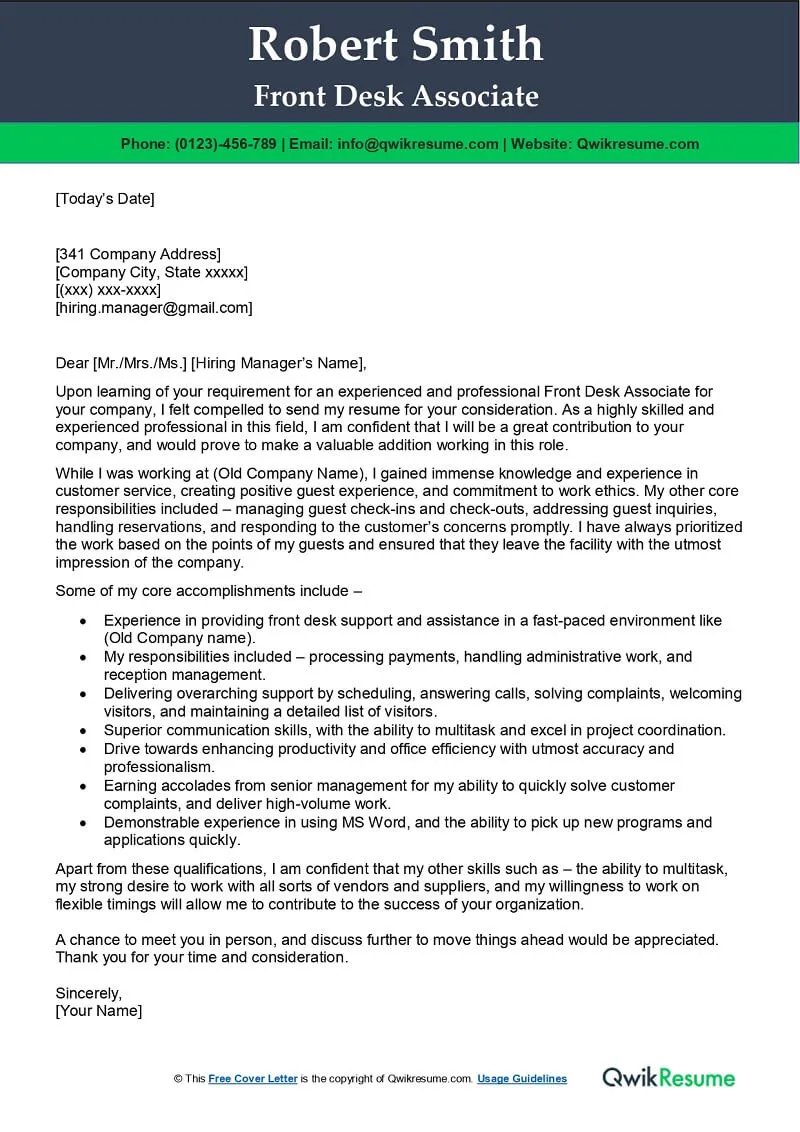
Sending a generic cover letter that isn’t tailored to the specific job and company is a major mistake. Generic letters lack the personalization and specific detail necessary to demonstrate your interest and qualifications for a particular role. Avoid using templates that are too broad or that do not address the specific requirements mentioned in the job description. Employers can easily tell if a cover letter is generic and they tend to ignore applications that are not tailored to their needs. Always customize your cover letter, referencing the company’s name and the specific role’s requirements. Show that you have invested time and effort in your application by providing context and illustrating how you align with their specific needs.
Typos and Grammatical Errors
Typos and grammatical errors can significantly damage your credibility and undermine your professionalism. These mistakes signal a lack of attention to detail, which is a crucial skill for a front desk associate. Before submitting your cover letter, carefully proofread it multiple times and use spell-checking tools. Consider having someone else review your letter for errors, as a fresh pair of eyes can often catch mistakes that you might miss. A polished, error-free cover letter demonstrates your commitment to quality and helps to build a positive impression. Always triple-check your cover letter for accuracy, paying attention to grammar, spelling, and punctuation. Correcting these mistakes will elevate your application and your chances of success.
Failing to Tailor the Letter
Failing to tailor your cover letter to the specific job requirements is a frequent mistake. The best cover letters address the specific needs and requirements outlined in the job description. If you do not tailor your letter to the role, it is unlikely to stand out from the crowd. Always review the job description carefully and address the key qualifications and skills the employer is seeking. Highlight how your experience and skills meet these requirements and provide examples to back up your claims. Customize your letter to showcase your suitability, using the keywords mentioned in the job description. Personalizing your cover letter demonstrates your effort and increases your chances of getting invited for an interview.
Reviewing Cover Letter Examples
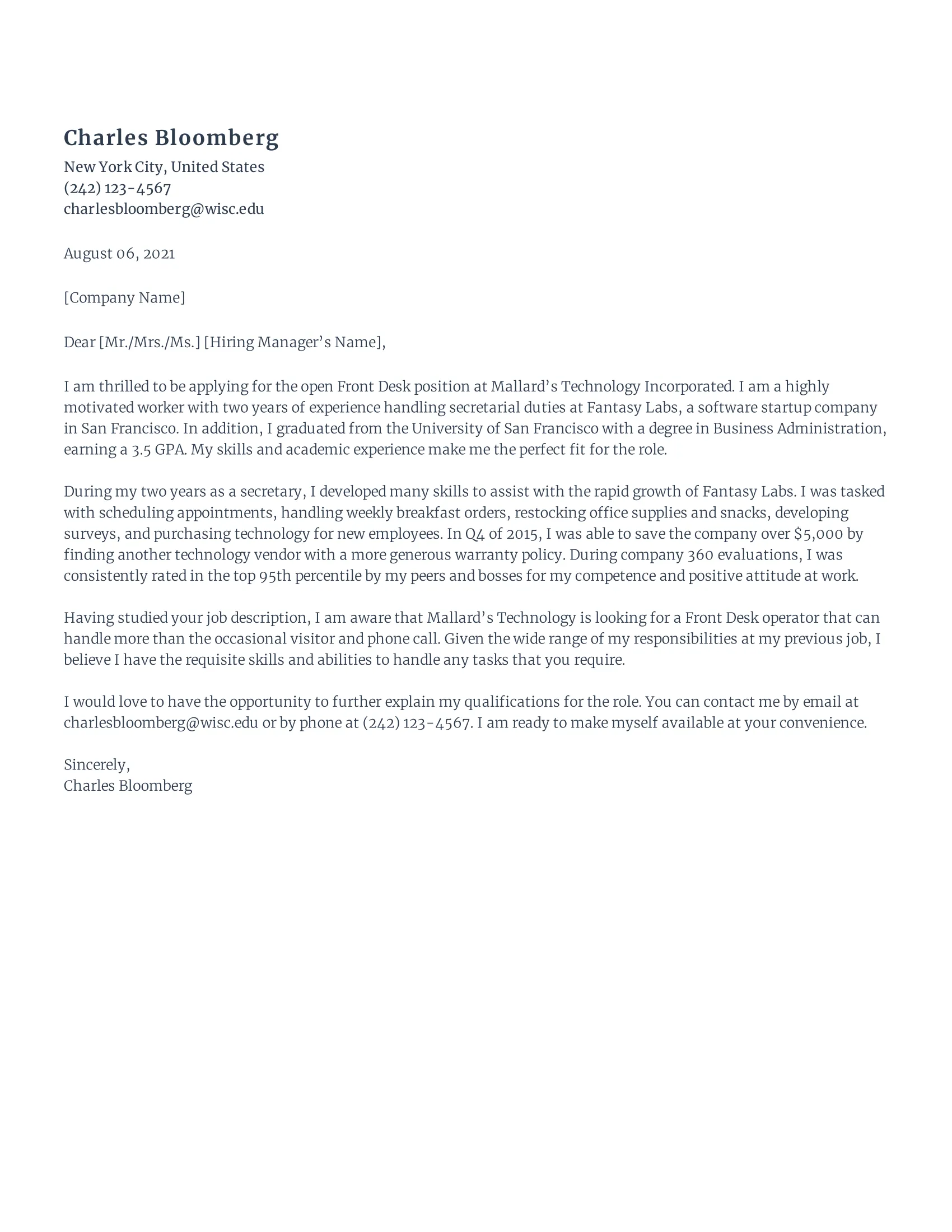
Reviewing examples of successful front desk associate cover letters can provide valuable insights into structure, content, and formatting. These examples can help you understand how to effectively communicate your skills and experiences, while also giving you ideas on how to personalize your own letter. By studying examples, you can gain a better understanding of what employers are looking for and how to present yourself in the best possible light. Use these examples as a guide, but make sure to tailor your own letter to reflect your unique skills and experiences. Adapt these examples and customize the structure to fit your own experiences and thus make your application more effective.
Example Cover Letter Structure
Most successful cover letters follow a standard structure. Start with your header containing your contact information and the date, then include the hiring manager’s information. Begin with a personalized greeting. In the opening paragraph, state the position you are applying for and mention where you saw the job posting. The body of the letter should highlight your relevant skills, experiences, and achievements. Use specific examples and quantify your accomplishments whenever possible. In the closing paragraph, restate your interest in the position and thank the reader for their time. End with a professional closing and your name. Following this structure ensures your letter is well-organized and easy to read. Sticking to this structure helps you to present your best side.
Adapting Examples to Your Experience
While reviewing cover letter examples, it is important to adapt them to your individual experiences and skills. Avoid simply copying and pasting text from these examples. Instead, use them as a guide to understand how to effectively present your qualifications and experiences. Replace the example content with your own information, highlighting your relevant achievements and skills. Tailor the letter to the specific job requirements, emphasizing how your background aligns with the employer’s needs. Personalizing your cover letter this way ensures that it reflects your unique strengths and shows employers that you are a good fit. This customization will elevate your application and increase your likelihood of securing a job interview.
